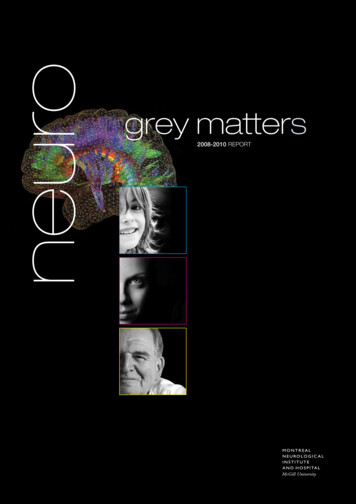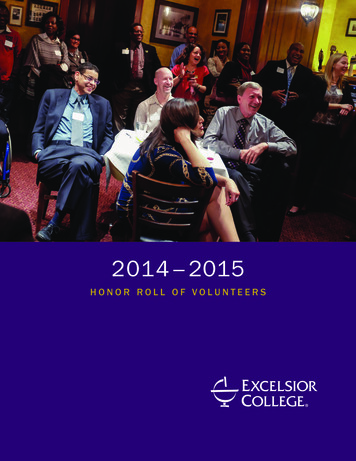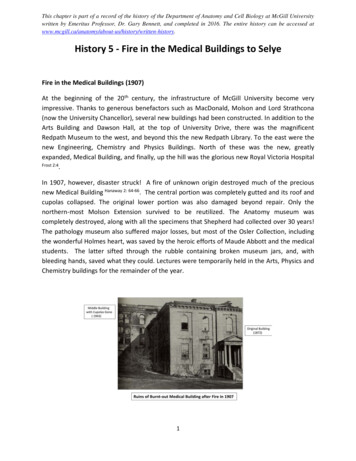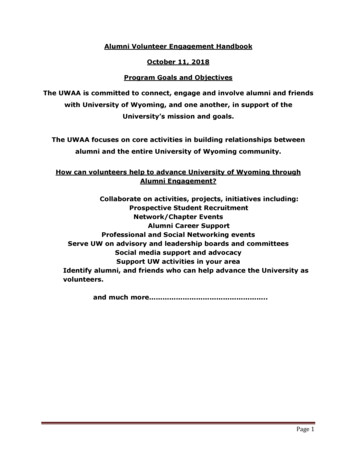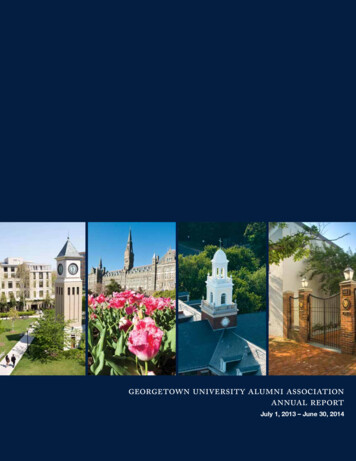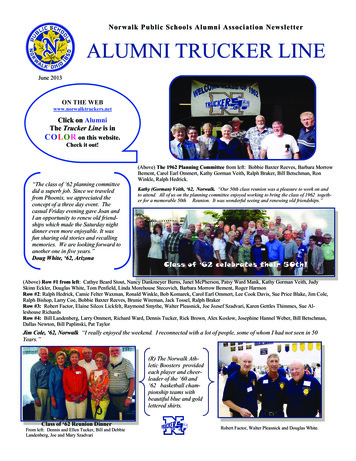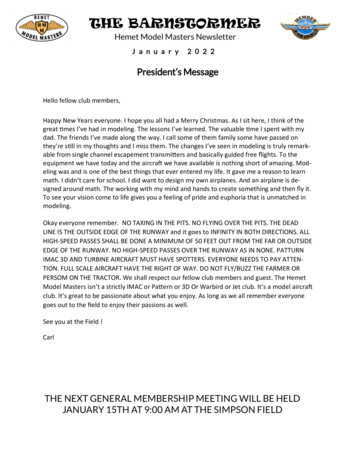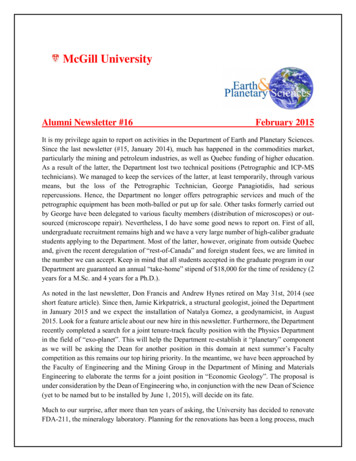
Transcription
McGill UniversityAlumni Newsletter #16February 2015It is my privilege again to report on activities in the Department of Earth and Planetary Sciences.Since the last newsletter (#15, January 2014), much has happened in the commodities market,particularly the mining and petroleum industries, as well as Quebec funding of higher education.As a result of the latter, the Department lost two technical positions (Petrographic and ICP-MStechnicians). We managed to keep the services of the latter, at least temporarily, through variousmeans, but the loss of the Petrographic Technician, George Panagiotidis, had seriousrepercussions. Hence, the Department no longer offers petrographic services and much of thepetrographic equipment has been moth-balled or put up for sale. Other tasks formerly carried outby George have been delegated to various faculty members (distribution of microscopes) or outsourced (microscope repair). Nevertheless, I do have some good news to report on. First of all,undergraduate recruitment remains high and we have a very large number of high-caliber graduatestudents applying to the Department. Most of the latter, however, originate from outside Quebecand, given the recent deregulation of “rest-of-Canada” and foreign student fees, we are limited inthe number we can accept. Keep in mind that all students accepted in the graduate program in ourDepartment are guaranteed an annual “take-home” stipend of 18,000 for the time of residency (2years for a M.Sc. and 4 years for a Ph.D.).As noted in the last newsletter, Don Francis and Andrew Hynes retired on May 31st, 2014 (seeshort feature article). Since then, Jamie Kirkpatrick, a structural geologist, joined the Departmentin January 2015 and we expect the installation of Natalya Gomez, a geodynamicist, in August2015. Look for a feature article about our new hire in this newsletter. Furthermore, the Departmentrecently completed a search for a joint tenure-track faculty position with the Physics Departmentin the field of “exo-planet”. This will help the Department re-establish it “planetary” componentas we will be asking the Dean for another position in this domain at next summer’s Facultycompetition as this remains our top hiring priority. In the meantime, we have been approached bythe Faculty of Engineering and the Mining Group in the Department of Mining and MaterialsEngineering to elaborate the terms for a joint position in “Economic Geology”. The proposal isunder consideration by the Dean of Engineering who, in conjunction with the new Dean of Science(yet to be named but to be installed by June 1, 2015), will decide on its fate.Much to our surprise, after more than ten years of asking, the University has decided to renovateFDA-211, the mineralogy laboratory. Planning for the renovations has been a long process, much
of it overseen by Prof. Jeanne Paquette. The rooms will be converted into a modern teaching roomwith a number of group workstations, new mineral collection storage cabinets, central teachingplatform and multiple video screens. The cost of the renovations exceeds 500K . Alumni will nolonger be able to reminisce about their circa-1955 classroom. A proposal has also been submittedto replace many of our aging ( 60 years old) petrographic microscopes.Field schools and trips remain a central part of our students’ education (see several feature articlesin the newsletter. In order to better prepare our students for work in the field, the Department will,starting in September 2015, offer a new mandatory course, called “Geology in the Field”, in theFall of the first year of the undergraduate program. Field School II and III will be replaced by anew, single 6-week Field School that will encompass various aspects of igneous, metamorphic,and sedimentary geology as well as geophysics and geochemistry.Of particular note, several of our faculty members (Don Baker, Jeffrey McKenzie, GalenHalverson, William Minarik) have been involved in the organization of the AGU-GAC-MACCGU Joint Assembly that will be held in Montreal on May 3-7, 2015 at the Palais des Congrès.An EPS reception has been scheduled for Tuesday evening, May 5th, at Brasserie BENELUX (245Sherbrooke) from 6-8 pm. Hope many of you will be able to join us.Overall, despite the current and expected future budget cuts, the Department is in fairly good shape.Alfonso Mucci, ChairAlfonso Mucci and Chloe Martias aboard the Coriolis
New FacultyAssistant Professor - James (Jamie) KirkpatrickI joined the faculty in Earth and Planetary Sciences in January as a structural geologist. I aminterested in all aspects of structural geology, from faults and fractures to shear zones to fold andthrust belts. My students and I use field and microstructural observations of deformation structuresto investigate the kinematics and mechanics of rock deformation. My main focus areas are faults,fault mechanics, and how faults control fluid flow in the subsurface, topics relevant to earthquakehazard, induced seismicity and hydrocarbon exploration and production.
One of the key aspects to my research is using tools to collect digital field data. My group and Iuse terrestrial laser scanner (TLS, aka ground-based LiDAR), differential GPS, and the Structurefrom Motion method to develop 3D models of rock exposures that we can use to calculate thegeometry of structures and develop statistical descriptions of structure frequency, orientation andother spatial properties. These methods are field based, and I am fortunate to be able to center myresearch program on areas in California, Nevada, Utah and Colorado where there are plenty ofrock outcrops. Work in the lab is also a large part of my research, and ranges from microstructuralwork to characterize fault rocks and mylonites to kinematic and mechanical modelling tounderstand the physical conditions and processes under which structures form.The large datasets that can be collected using digital tools provide new insights and freshchallenges for structural geology. For example, I have developed new methods for measuringslickenline orientations on fault surfaces from TLS data. Hundreds of measurements can be maderapidly, and the measurements are embedded in a digital elevation model of the surface so can becoupled with geometric information. Fault surfaces are rough and corrugated, but I discovered thatthe slickenlines stay straight across a fault, even as the surface orientation changes. Since highstress across a bumpy fault surface would have caused local distortions in the slickenline field, Ishowed that the shear resistance on faults is actually less than laboratory experiments havepredicted (in other words, faults are weaker than we think!)My current undergraduate and graduate students are pursuing some of these ideas further, andtaking them in new directions. Current projects include integrating numerical models of the stressfield around faults with field and core measurements of fracture frequency and orientation toconstrain the strength of major faults over the seismic cycle; measuring fault surface geometry toinvestigate wear processes and how earthquake ruptures depend on the faults upon which theyoccur; and investigating mixed brittle-ductile behaviour in shear zones to determine the stress,strain rate or pore pressure conditions that cause fracture nucleation. We are also testing methodsfor measuring topography at outcrop and grain scales by using new software to build digitalelevation models from standard photographs.I aim to build my research program at McGill around the themes of fault and earthquakemechanics, fracturing and fluid flow, and instability in ductile shear zones. In addition tocontinuing field-based research, I am collaborating with scientists in the US, Japan and elsewhereto design borehole experiments to investigate earthquake processes and how pumping fluids intothe subsurface can stimulate earthquakes. Samples and geophysical measurements of faults andthe surrounding formations at depth in the crust can provide unique insights into the physical andchemical processes driving deformation.I arrived at McGill from Colorado State University where I was an assistant professor for twoyears. Prior to Colorado, I was a postdoc at the University of California, Santa Cruz working inthe seismology group. I was an undergraduate at the University of Leeds in England, and movednorth to Glasgow, Scotland for my PhD at the University of Glasgow. I am excited to join thefaculty in EPS and am looking forward to exploring Québec’s geology and contributing to theexcellent teaching and vibrant atmosphere in the department!
Don FrancisProfessor Emeritus – 31 May 2014Don on horseback – Days Land, AlbertaDon with daughter, Abby – Vancouver Island
Andrew HynesProfessor Emeritus – 31 May 2014I joined what was then the Department ofGeological Sciences at McGill in the early summerof 1975. I was hired in response to an advertisementfor a Structural Geologist/Precambrian Geologist.Not really being either of these, I was able to get theposition only by arguing that I could teach thesesubjects at an undergraduate level and that, at leastwhere Precambrian geology was concerned, it wasmy intention to direct my research to theapplicability of plate-tectonic processes in thePrecambrian. My teaching responsibilities were tobe for structural geology, metamorphic petrologyand field school.Andrew seated with twin brother, Julian, and their olderbrother, Richard, looking on from behind – photo takenat Pinnacle (Sutton) – September 2007My first McGill-based research was directed to the Paleoproterozoic northeastern Labrador Trough, andserved as a very good introduction to the demands and requirements of research in northern Canada. I thenestablished a joint research program with Don Francis, investigating the tectonic evolution of thePaleoproterozoic Cape Smith foldbelt in the northern Ungava Peninsula, a project that entrained severalgraduate students and embraced five or six field seasons. I took my first sabbatical leave in 1981-82, whenthe Cape Smith project was largely wound up, and spent 3 months in Auckland, New Zealand and 6 monthsin Australia, where I conducted research on the metamorphism of mafic volcanic rocks and on the tectonicevolution of the Paleoproterozoic Capricorn Orogen in Western Australia. By this time I had managed todivest myself at least in part of the teaching of metamorphic petrology, because Willy Williams-Jones hadarrived at McGill and could share the load.On my return from sabbatical leave, I worked with my graduate students on a variety of different tectonicsprojects, including investigating the Archean greenstone belts in the James-Bay area, again in collaborationwith Don, in the Canadian Cordillera, partly in collaboration with Eric Mountjoy, with whom I also cosupervised several students, and in the Labrador Trough. I became Chairman of the Department in 1987,and held that post until 1991, when I took my second sabbatical leave, at the University of Cambridge. Ihad by this time significantly developed my interests in geodynamics. I spent much of the year working onthe dynamics of extrusion of high-pressure metamorphic rocks, as well as modelling the seismic
characteristics of such rocks using basic thermodynamic data for their mineralogy, in collaboration withCambridge geophysicists.Following this sabbatical, I became closely involved with the Lithoprobe project, first working on theManicouagan transect of the Mesoproterozoic Grenville province, and later on the Western Superiortransect in the Archean of northwestern Ontario. The Lithoprobe project was in a sense ideally suited tomy background, combining as it did geophysical with geological approaches to tectonic problems. I alsobecame Director of Graduate Studies in the Department, a post I held with only a two-year break aroundthe time of my third sabbatical leave in 2001-2002 until I again became Chair (this time an article offurniture rather than a person) in 2010. While in my position as Chair, I also served on the UniversitySenate, as appears to have become the common practice for Chairs in the Faculty of Science.I relinquished the Chair in 2013, and took my final sabbatical leave, which I have spent at the Universityof Salamanca and in Cyprus. The focus of my research has returned to more recent times; I am studyingthe Variscan (Hercynian) orogeny, which reflects the final assembly of Pangea following the collision ofGondwana and Laurasia in late Carboniferous time.I note in conclusion that the major target of my research aims when I came to McGill in the seventies – toestablish whether or not plate tectonics had been operative in the Precambrian – remains a subject ofsignificant debate, at least for Archean times. There is, happily, still much to be discovered.Myrna & Andrew Hynes on sabbatical in Cyprus (2014)
Graduate Student Field TripThetford MinesSeptember 2013EPS Field Trip for New Grads to Thetford Mines - lead by Don Francis and Christie Rowe.Students from left to right: Tim Gibson, Sri Utami, Longbo Yang, Kalina Malowany, NaomiBarshi, Lucas Kavanagh, Charles Beard, Sarah Bodeving, and Sam Broom-Fendley.– photo was taken at the top of Mont Ste Gregoire
ALUMNI NEWSEric Galbraith (B.Sc. ’97) and Maria Pastor are overjoyed toannounce the birth of their son Thomas Aran GalbraithPastor on Monday, September 2, 2013! Maria put the 'labour'in Labour Day - her waters broke at 5:30 am and she gave birthat 2:12 pm! She was a total warrior princess throughout therollercoaster ride – Eric never before witnessed such strength.Maria recovered well, and Thomas is doing great - exerting hispowers of mind control over them, and keeping thementhralled with his big blue eyes and his Houdini-like abilityto squirm out of even the tightest swaddling.
Hello Muriel Noella Filion! – KristyThornton (B.Sc. ’00) and Paul Filionwelcomed the birth of their daughter onThursday, January 23, 2014 at 10:08pm (almost a month early!) – MurielNoella was born 48 cm long andweighed 2.595 kg!Paul & Kristy –EPS Baby Shower –Friday, January 17, 2014Muriel Noella with Froggy!
Geology Alumni Reunionat PDAC EPS ReceptionMonday, March 3, 2014In conjunction with the 2014 PDAC Convention in Toronto, Earth &Planetary Sciences hosted the 4th Annual Geology Reunion at FarNiente & Four Restaurants on Monday, March 3, 2013 (7:30 – 10:00pm). Fellow Geology alumnus caught up with each other and spokewith the current Chair of Earth and Planetary Sciences, Alfonso Mucci,discovering what's happening with the EPS, MinEx, Faculty, etc.!Left to right: Bob Wares, Caroline Wilson, Jim Clark, Karen Olsen Hoal, Bob Linnen, Mike Hamilton, CharlesBeaudry, and Isabelle Cadieux
Mike Flanagan and Alfonso MucciBob Wares and Karen Olson
David (Duff ) Gold and Louis CabriDirk Schumann, Mohadeseh Majnoon, Kayla Helt, and Sean Dubois
Roger Thomas and Fred FelderKarin Olsen and BJ McKay
Sergio Cattalani and David PalmerCrystal Mann and Vincent van Hinsberg
Viktoria Maneta, Sean Dubois and Henrik VeldhuyzenLaura Maharaj, Sergio Cattalani, Anne Kosowski, Alfonso Mucci, and Sam Scher
Dejan MilidragovicPh.D. Defense – 19 March 2014Dejan (Day-an) Milidragovic is a Ph.D. student studying with Prof. Don Francis in the Department ofEarth and Planetary Sciences at McGill University. He began his investigation of ca. 2.7 Ga mafic andultramafic intrusions in northern Quebec and the role of ferropicritic magmas in Neoarchean cratonizationin September 2008. He received his M.Sc. (2008) and B.Sc. (2005) degrees from Simon Fraser Universityin Vancouver, BC.Neoarchean (2.7 Ga) reworking of the Ungava craton by Fe-rich parental magmasThe Neoarchean was a time of enhanced continental crust formation and wide-spread mafic magmatismrelated to global mantle melting. Mafic and ultramafic intrusions were emplaced across a large portion ofthe Ungava craton of the Northeast Superior Province, synchronous with the crystallization of largevolumes of ca. 2.74-2.70 Ga intermediate to felsic plutonic rocks. The ca. 2.72-2.70 Ga mafic/ultramaficintrusions are locally known as the Qullinaaraaluk, Chateguay and Couture plutonic suites, and are hereinreferred to as the Q-suite. The Q-suite plutons have relatively unfractionated MREE/HREE ratios, variablyelevated LREE/MREE ratios and strong depletions in HFSE, in particular Nb and Ta. The high Th/Yb ratiosand chondritic to strongly radiogenic initial 143Nd/144Nd (2.72 Ga) ratios of the Q-suite intrusions suggestthat their “calc-alkaline” trace element profiles may reflect the addition of significant tonalite-trondhjemitegranodiorite (TTG) component. The interaction between the Q-suite magmas and TTG crust is also evidentin “hybrid” domains of intermediate-SiO2 content (50-65 wt. %) that form along the margins of someintrusions. These “hybrid” domains strongly resemble the intermediate-SiO2 members of the voluminousca. 2.74-2.70 Ga pyroxene-bearing granitoids that make up more than 20% of the exposed surface of theUngava craton. Mass- balance and thermodynamic modelling suggests that pyroxene-bearing granitoidswith 65 wt. % SiO2 contain a significant juvenile (Q-suite) component modified by 40-50 % addition oftrondhjemitic melt of the pre 2.74 Ga TTG crust.Don Francis and Dejan Milidragovic
Analyses of olivine (FoMax 0.84) from peridotitic and dunitic cores of the Q-suite intrusions(Mg-number 0.82), suggest that their parental magmas were enriched in Fe relative to presentday MORB, or hot-spot related magmas. The Q-suite intrusions of western and southern Ungavacraton crystallized from magmas of subalkaline affinity, in contrast to the intrusions of the northcentral Ungava craton which are mildly subalkaline to mildly alkaline (transitional). Parental liquidcompositions of the subalkaline and transitional Q-suite intrusions estimated using the programalphaMELTS are Fe-rich high-Mg basalts (MgO 10 wt. %, FeOTOT 13.5 wt.%, Al2O3 15wt.% ), and Al-poor ferropicrites (MgO 14 wt. %, FeOTOT 17 wt.%, Al2O3 6.6 wt.%),respectively. These compositional differences may reflect melting of compositionallyheterogeneous Fe-rich mantle sources under similar P-T conditions, or different degrees of meltingof a common Fe-rich mantle source under different P-T conditions. The transitional parentalmagmas appear to represent high degree melts that last equilibrated with a harzburgitic residue,whereas the subalkaline parental magmas appear to represent lesser-degree partial melts that lastequilibrated with a lherzolitic mantle residue.The craton-wide distribution of Q-suite plutons and the large inferred Q-suite component in theca. 2.74-2.70 Ga pyroxene-granitoids, suggests that ferropicritic underplating may have been asignificant driving force in the reworking of the Ungava craton. Ferropicrites of similar age havealso been emplaced into the southern and western Superior Province, as well as the Slave, W.Churchill, Kaapvaal, Yilgarn and Karelia cratons. The identification of ferropicritic rocks in atleast five other Archean cratons suggests that melting of Fe-rich mantle domains may have had animportant role in global cratonization ca. 2.7 Ga.Dejan Mildragovic and Julia King (M.Sc. 2012)
McGill Alumni Association2014 Student Engagement AwardAnita MountjoyEvery year the McGill Alumni Association recognizes those alumni and friends whose commitment hashad a particularly significant impact on student life and on the University itself. The MAA has selectedAnita Mountjoy to receive it’s Student Engagement Award in recognition of Anita’s outstandingdedication to McGill students over the last 50 years. Anita’s kindness and caring have benefited manystudents over the 50 years she has been involved with McGill and she remains a well-loved and respectedindividual on campus. Anita’s commitment to education and the well-being of our students stands astestimony to her strong and evident belief in the value of McGill’s mission.Anita’s relationship with McGill began in 1963 when she first came to Montreal with husband, EricMountjoy. She completed her BN in 1966 and her M.Sc. Nursing in 1976. She quickly became part of theMcGill family and, with Eric, would accompany students every summer into the field.An avid cross-country skier and superb cook, Anita would feed countless students over the years, many ofwhom would return again and again to visit her after graduation. Anita remains close to Earth & PlanetarySciences – Tim Gibson (inaugural recipient of the Eric Mountjoy Fellowship – Fall 2013 – photographedbelow with Anita Mountjoy) commented that he’d already been over to Anita’s house and that he andanother graduate student were speding Thanksgiving (2013) with her Tim met Anita for this first timeat the EPS annual BBQ on Mont Royal – “Anita has shown immense warmth from the beginning. Shehosted my girlfriend and me for dinner and Thanksgiving, and invites me to events she attends on campus.Each time I visit her home she lets me explore photographs from Eric’s fieldwork, his unfinished maps, andhis book collection, and each time Isee her elsewhere she has a newstory of Eric to tell. Eric and Anitaadopted a strong tradition ofmentorship from Eric’s PhDsupervisor, Frank Beales, fiftyyears ago and have continuedacting as surrogate parents since.Although I am grateful for Anita’shome cooked meals (she won’tallow anyone to do dishes), I ammost astonished that she has time tobe so gracious considering howmany others she helps.”EPS staff and students alike, always look forward to seeing Anita - she holds a very special place in all ourhearts, and we are very grateful for her compassion, thoughfulness, generous spirit, and humanity!
Eric Mountjoy FellowshipInaugural Recipient – Fall 2013Timothy GibsonTimothy (Tim) Gibson (Ph.D. student)Anita Mountjoy in audience with alumnist, Principal Suzanne Fortier (Ph.D. ’76)
EPS Valentine’s Wine & CheeseFriday, February 14, 2014Left to right: Kirsten McGraw, Jennifer Kambhampati, Bob Wares, Tim Gibson, and Anita Mountjoy
Captain Africa (Adams Club)VSMuch Mucci (EPS Faculty)Best of 5 games squash match fundraiser for Grad Field Trip to Rockies – August 2014Tickets were 3 each or 10 for 4 tickets - to a maximum of 8 tickets each.If Much Mucci (Alfonso Mucci) wins - two tickets will be drawn from those who bet on him - 1st prizewill receive 5% of all the funds raised & a bottle of scotch, 2nd prize gets a bottle of wine.If Captain Africa (Nils Backeberg, Ph.D. student) wins and you bet on him – 1st will receive 10% & abottle of scotch, and 2nd prize gets a bottle of wine.MATCH RESULTS (14 Feb 2014) : Captain Africa – 0 and Much Mucci - 3TICKET WINNERS: 1st Prize – Bob Wares, and 2nd Prize – Anne KosowskiThe Graduate Student Field Trip isaimed at educating graduate studentsin the diverse Canadian and NorthAmerican geology outside their dailyresearch projects. In August 2014, thefield trip is planned to cover acomplete transect of the CanadianCordillera from Calgary to Vancouverover a two week period in lateAugust. The geological aims arebroad in scope covering deformationstructures, sedimentary packages,volcanic sequences, metamorphicterranes, ore deposits, as well asgaining an overall appreciation for thegeology of western Canada.Economic highlights of the trip willinclude: porphyry deposits around theKamloops area, gas and oil reservoirs,structural traps and conduits related tothe foreland fold and thrust belt,geothermal springs and fossil parks.Other highlights will include thelagerstätten Burgess Shale, Rockymountain geomorphology and vistasand networking amongst ourmembers and local professions in theregion they shall be visiting.
Ph.D. students Nils Backeberg (left), from South Africa, and Jason Coumans play hockey on the outdoorrink at the centre of McGill’s downtown campus(Photo taken by Montreal Gazette - 25 February 2014)McGill students playing hockey – circa 1865-1880
1st Year Field TripSeptember 2014The 1st year field trip, lead by Jeanne Paquette and Bill Minarik, left the Adams building (8:30am sharp!) to head up the mountain. After examining the rocks there and visible around, weboarded a bus for three more stops: Couteau du Lac (Stromatolites in the Beekmantown), Pointedu Buisson (trackways in the Potsdam and fossil earthquake injectites, and finally the HansonBrickyard to find fossils).Jeanne Paquette – domomitizing
Fossils - Hanson BrickyardComparing Fossils – Hanson Brickyard
Fossil picking – Hanson Brickyard
EPSC 425 - Shell CanadaSedimentology Field Trip March 2014:Neogene Basins of Southeastern SpainAs part of EPSC 425 (Sediments to Sequences) and a coupled graduate course on sedimentarybasins, 25 undergraduate students, 7 graduate students, and I traveled to southern Spain in Marchto visit the Neogene sedimentary basins of Almería Province, Andalucia. Home to the driestclimate in western Europe and the sets of several movies (including The Good, the Bad, and theUgly and Lawrence of Arabia), southeastern Andalucia has to be one of the best places in the worldto run a sedimentology field trip. It helped that we enjoyed almost perfect weather, even as familyand friends back home suffered through yet another frigid week!Day 1. The 32 students and I met in Málaga, and after a few bumps in the road resulting fromdelayed flights, we set off for Alméria late Saturday morning. Due to the late start, we did not havetime for any stops along the way, with the exception of lunch on the beach at Alumuñecar. Wearrived in Carboneras after the sun had set and settled into our apartments that were to be our homefor the next four nights—a stone's throw away from the Mediterranean.Day 2. After an early start, we spent the day in the Sorbas basin, one of several small andgeographically distinct sedimentary basins that flanks the basement uplifts in the region. Followingan overview of this and the other basins in the area, we settled into an afternoon ofTaking it all in from the Cantona Hill overlook in the Sorbas Basin
investigating marginal marine sequences in the town of Sorbas. Here we saw tidal deltas, barrierisland systems and accompanying lagoonal deposits, and fluvial sediments deposited in a basininfluenced by rapid subsidence rates and glacioeustatic sea level fluctuations.Day 3. We spent one more day in the Sorbas basin, this time focusing on the orbitally-driven cyclesin the Abad and Yesares bembers (see figure below). The Yesares Member contains abundantgypsum deposited during the tail end of the Messinian salinity crisis, about 5 million years ago.While I had seen gypsum in the field before, never had I seen it so well developed, nor in such aninteresting context within Earth's history. The immense 'gypsume supercones' especially impressedus. We finished off our day with a tour of caves carved out of the gypsum and associated marls.Morning view from the top of a plateau held up by gypsum of thebasal Yesares (Messinian) MemberDay 4. We shifted or focus to the Tabernas basin, beginning in 'Little Hollywood' where we spentthe more scrambling about alluvial fan sediments deposited on the margin of the basin. We thendescended into the depocentre of the basin, where we examined turbidites and other gravity flowsediments deposited in subaqueously carved canyons within a confined turbidite system. This iswhere undergraduate and graduate students alike learned that not all turbidites are created equal—that is, they do not obey the usual rules when deposited within confined systems. In the lateevening, we descended to the coast within the scenic Cabo de Gatas to have a look at the Neogenevolcanics associated with the opening of the Alboran Sea.
Investigating an oblique longitudinal view of a confined turbidite system,filling a canyon that had been carved into marls in the core of the Tabernas basinDay 5. After bidding a sad adieu to our seaside abode in Carboneras, we wound our way through the basinsand mountains to the western margin of the Tabernas basin, where we met up with Fernando García García,a sedimentologist at the Universidad de Jaén, who graciously offered to show us Gilbert deltas in theTabernas and Guadix basins. At our first stop, we saw a series of Gibert delta system deposited in a rapidlysubsiding basin, which each delta system deposited during a separate glacioeustatic cycle. Due to the therapid generation of accommodation space, the topsets here were very well developed and clogged withcoarse sediments, including cobbles deposited in fluviodeltaic bars, but reworked by waves. After a lazylunch in the syn, we relocated to the Guadix basin, which sits on the north side of the aptly named SierraNevada, which includes the tallest peak in mainland Spain. Here we saw more glacioeustatically drivencycles, but this time developed on a tidally influenced, mixed carbonate-clastic ramp (see below). We thenrepaired to our hotel in Guadix, where most of us enjoyed a dinner of tapas.The group with Fernando (far left) sitting in front of the tidally influenced ramp cycles (uplifted following deposition, such thatthese are not foreslope deposits!). The Sierra Nevada is in the background.
Day 6. This was our last day in the field. We spend the morning looking in more detail at thesediments deposited on the tidally influenced ramp on the margin of the Guadix basin. In theafternoo, we relocated to the northern part of the basin, where we investigated another Gilbertdelta. This one, however, was deposited during an episode of forced regression resulting fromuplift of flanking Mesozoic basement. The result was a Gilbert Delta where the coarse-grainedsediments were deposited in the bottomsets and foresets, along with shrinking foresets reflectingthe shallowing of the basin. Great stuff!A Gilbert delta deposited on the uplifting flank of the Guadix basin, north of the Sierra Nevada. Notice thedecreasing hei
the seismology group. I was an undergraduate at the University of Leeds in England, and moved north to Glasgow, Scotland for my PhD at the University of Glasgow. I am excited to join the faculty in EPS and am looking forward to exploring Québec's geology and contributing to the excellent teaching and vibrant atmosphere in the department!
